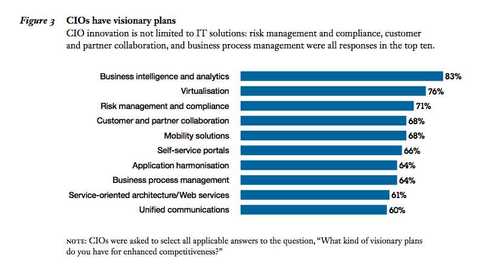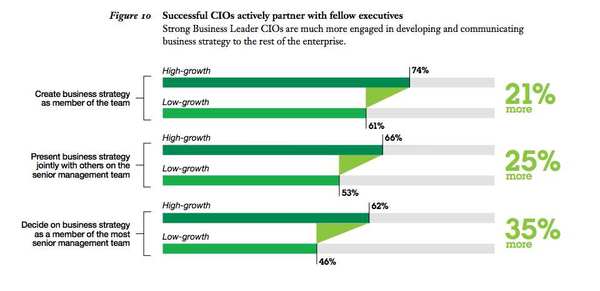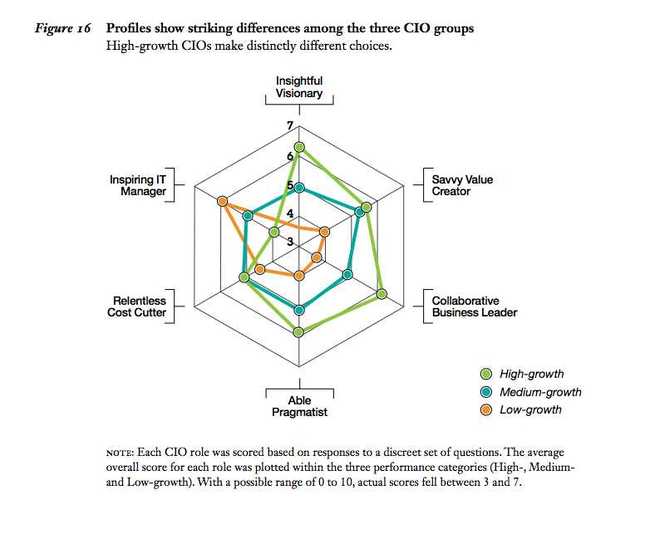CIO full face and profile - IBM version
Caught the eye the results of a survey conducted by IBM 2,5 thousand CIO. They polled 19 industries around the world, including in Russia. The study was conducted, apparently, in the format of a personal conversation, with minimal inclusion of formalized questionnaires. The results were broken down into three groups of companies: fast-growing, “middling” and slow-growing (this is probably the minimum level for IBM customers), and they compared which are where CIOs work and how they live.
Some of the results are fairly obvious and duplicated from the survey to the survey, but something seemed interesting.
The immediate implementation priorities for IBM's CIOs surveyed are business intelligence (by a wide margin) and virtualization. About virtualization is understandable, but business analysts, it seemed, everyone ate a couple of years ago. It turns out that no. And for some reason, not very high places are taken by portals and other web solutions, which, to this day, also looks rather strange.
')

It seems almost fiction that the CIO respondents think about the clients of their native company and how to engage them more closely in interactive interaction, promptly receive requests / wishes / information from clients and modify their systems to suit their needs. In the next five years, 87% of CIOs of fast-growing companies will implement solutions to improve this interaction. In slow-growing companies, this figure is 70%, which is actually a lot. According to my impressions, in the fatherland, IT directors have not always managed to interact smoothly with the business subdivisions of their own company, and even thinking about customers ... No, they, of course, know about the existence of such a thing as a client, but to get him in IT plans - before that, it seems still to grow and grow.
Be that as it may, the CIO from the IBM survey suggests that such client-centricity will require high integration and data transparency, so 68% of “fast-growing” and 44% of “slow-growing” plan to purchase or develop the appropriate software.
Kau found out IBM, 14% of CIO's work time is dedicated to “cutting off” costs (and I’m representing a sullen CIO who painfully cuts out the necessary articles from the IT budget). According to the respondents, one of the best ways to cut costs is to rigidly centralize the infrastructure - not necessarily in the physical sense, but rather in terms of management. 3/4 of respondents plan to engage in centralization in the next 5 years. Another item in the cost reduction program is the introduction of fully standardized processes; “Fast-growing” 22% more often than “slow-growing” are planning such standardization.
A significant number of CIOs claim that they are somehow involved in the formation of a strategy. However, as follows from the chart below, making a strategic decision allows a much smaller number of respondents.

Interestingly, according to CIO, the company's business model should be unique, difficult to copy, and CIOs are going to implement just such solutions that support and enhance corporate uniqueness. It’s not quite clear where they are going to find them in the consolidating IT market, but the very tendency to move away from mass copying of successful models and processes may turn out to be interesting in some (not, I think, short-term) perspective.
Finally, IBM, in its report, lists the role profiles of CIOs depending on the growth rate of the companies in which they work.

As you can see, in slow-growing companies, the CIO is more likely to focus on the role of an IT manager, maintaining current infrastructures in order and quietly managing its department, while in fast-growing companies, CIO sees itself as an innovator and business leader.
In conclusion, IBM gives some tips on how to improve your own professional profile. Retelling is long, and the full version of the report (in English, registration is required) can be found here .
Some of the results are fairly obvious and duplicated from the survey to the survey, but something seemed interesting.
The immediate implementation priorities for IBM's CIOs surveyed are business intelligence (by a wide margin) and virtualization. About virtualization is understandable, but business analysts, it seemed, everyone ate a couple of years ago. It turns out that no. And for some reason, not very high places are taken by portals and other web solutions, which, to this day, also looks rather strange.
')

It seems almost fiction that the CIO respondents think about the clients of their native company and how to engage them more closely in interactive interaction, promptly receive requests / wishes / information from clients and modify their systems to suit their needs. In the next five years, 87% of CIOs of fast-growing companies will implement solutions to improve this interaction. In slow-growing companies, this figure is 70%, which is actually a lot. According to my impressions, in the fatherland, IT directors have not always managed to interact smoothly with the business subdivisions of their own company, and even thinking about customers ... No, they, of course, know about the existence of such a thing as a client, but to get him in IT plans - before that, it seems still to grow and grow.
Be that as it may, the CIO from the IBM survey suggests that such client-centricity will require high integration and data transparency, so 68% of “fast-growing” and 44% of “slow-growing” plan to purchase or develop the appropriate software.
Kau found out IBM, 14% of CIO's work time is dedicated to “cutting off” costs (and I’m representing a sullen CIO who painfully cuts out the necessary articles from the IT budget). According to the respondents, one of the best ways to cut costs is to rigidly centralize the infrastructure - not necessarily in the physical sense, but rather in terms of management. 3/4 of respondents plan to engage in centralization in the next 5 years. Another item in the cost reduction program is the introduction of fully standardized processes; “Fast-growing” 22% more often than “slow-growing” are planning such standardization.
A significant number of CIOs claim that they are somehow involved in the formation of a strategy. However, as follows from the chart below, making a strategic decision allows a much smaller number of respondents.

Interestingly, according to CIO, the company's business model should be unique, difficult to copy, and CIOs are going to implement just such solutions that support and enhance corporate uniqueness. It’s not quite clear where they are going to find them in the consolidating IT market, but the very tendency to move away from mass copying of successful models and processes may turn out to be interesting in some (not, I think, short-term) perspective.
Finally, IBM, in its report, lists the role profiles of CIOs depending on the growth rate of the companies in which they work.

As you can see, in slow-growing companies, the CIO is more likely to focus on the role of an IT manager, maintaining current infrastructures in order and quietly managing its department, while in fast-growing companies, CIO sees itself as an innovator and business leader.
In conclusion, IBM gives some tips on how to improve your own professional profile. Retelling is long, and the full version of the report (in English, registration is required) can be found here .
Source: https://habr.com/ru/post/76419/
All Articles